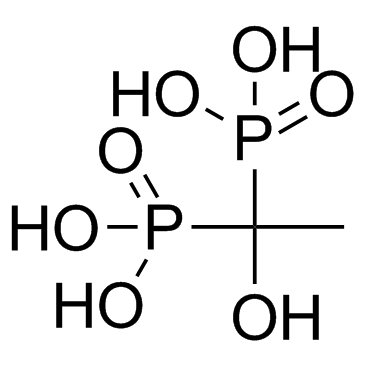In vivo phosphoantigen levels in bisphosphonate-treated human breast tumors trigger Vγ9Vδ2 T-cell antitumor cytotoxicity through ICAM-1 engagement.
Ismahène Benzaïd, Hannu Mönkkönen, Edith Bonnelye, Jukka Mönkkönen, Philippe Clézardin
Index: Clin. Cancer Res. 18(22) , 6249-59, (2012)
Full Text: HTML
Abstract
Nitrogen-containing bisphosphonates (N-BP) such as zoledronate and risedronate exhibit antitumor effects. They block the activity of farnesyl pyrophosphate synthase (FPPS) in the mevalonate pathway, leading to intracellular accumulation of mevalonate metabolites (IPP/ApppI), which are recognized as tumor phosphoantigens by Vγ9Vδ2 T cells. However, mechanisms responsible for Vγ9Vδ2 T-cell recognition of N-BP-treated tumors producing IPP/ApppI remain unclear.The effects of N-BPs on Vγ9Vδ2 T-cell expansion and anticancer activity were evaluated in vitro and in animal models of human breast cancers. The modalities of recognition of breast tumors by Vγ9Vδ2 T cells in N-BP-treated animals were also examined.We found a strong correlation between Vγ9Vδ2 T-cell anticancer activity and intracellular accumulation of IPP/ApppI in risedronate-treated breast cancer cells in vitro. In addition, following risedronate treatment of immunodeficient mice bearing human breast tumors, human Vγ9Vδ2 T cells infiltrated and inhibited growth of tumors that produced high IPP/ApppI levels but not those expressing low IPP/ApppI levels. The combination of doxorubicin with a N-BP improved, however, Vγ9Vδ2 T-cell cytotoxicity against breast tumors expressing low IPP/ApppI levels. Moreover, Vγ9Vδ2 T-cell cytotoxicity in mice treated with risedronate or zoledronate did not only depend on IPP/ApppI accumulation in tumors but also on expression of tumor cell surface receptor intercellular adhesion molecule-1 (ICAM-1), which triggered the recognition of N-BP-treated breast cancer cells by Vγ9Vδ2 T cells in vivo.These findings suggest that N-BPs can have an adjuvant role in cancer therapy by activating Vγ9Vδ2 T-cell cytotoxicity in patients with breast cancer that produces high IPP/ApppI levels after N-BP treatment.©2012 AACR.
Related Compounds
| Structure | Name/CAS No. | Molecular Formula | Articles |
|---|---|---|---|
 |
Etidronic acid
CAS:2809-21-4 |
C2H8O7P2 |
|
Translating clinical findings into knowledge in drug safety ...
2011-12-01 [J. Sci. Ind. Res. 65(10) , 808, (2006)] |
|
Effects of various squalene epoxides on coenzyme Q and chole...
2014-07-01 [Biochim. Biophys. Acta 1841(7) , 977-86, (2014)] |
|
FDA-approved drug labeling for the study of drug-induced liv...
2011-08-01 [Drug Discov. Today 16 , 697-703, (2011)] |
|
Biosorption of heavy metal ions onto agricultural residues b...
2012-11-28 [J. Agric. Food Chem. 60(47) , 11664-74, (2012)] |
|
Atorvastatin, etidronate, or both in patients at high risk f...
2013-06-11 [Circulation 127(23) , 2327-35, (2013)] |